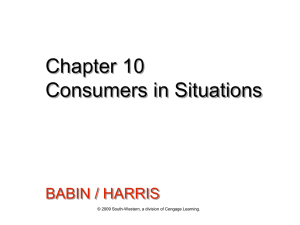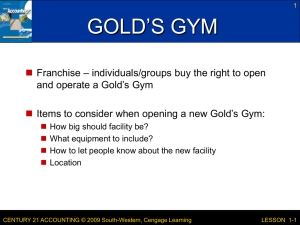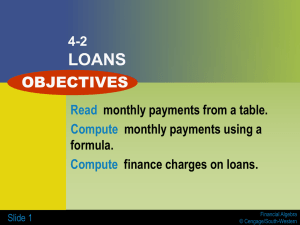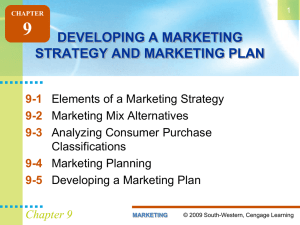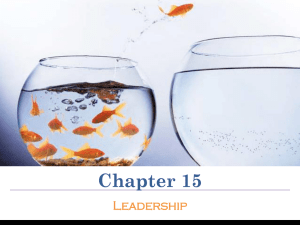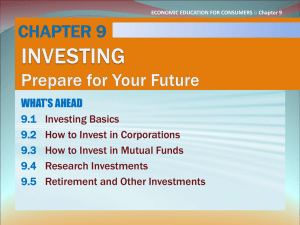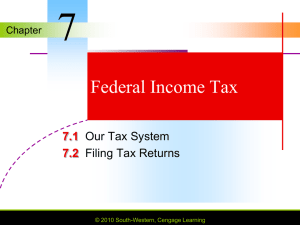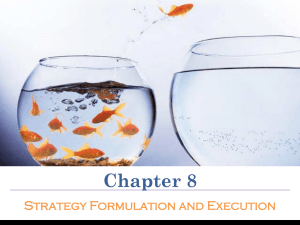Chapter 17 Credit Records and Laws
advertisement
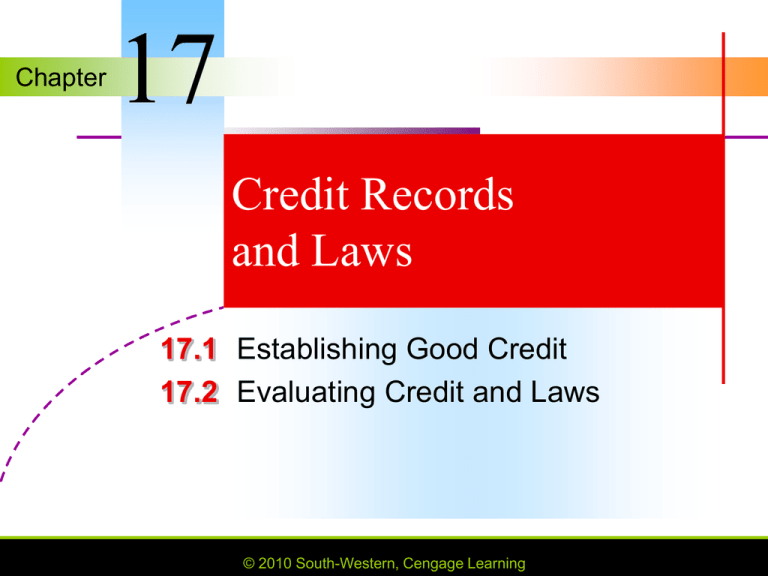
Chapter 17 Credit Records and Laws 17.1 Establishing Good Credit 17.2 Evaluating Credit and Laws © 2010 South-Western, Cengage Learning Lesson 17.1 Establishing Good Credit GOALS Discuss the purpose of credit records. Describe the concept of creditworthiness. Explain how to get started using credit. Chapter 17 © 2010 South-Western, Cengage Learning SLIDE 2 Credit Records Before granting you credit, a creditor will check into your past credit performance: Did you pay your bills on time? How much total credit did you receive? How much do you owe now and how large are your payments? Chapter 17 © 2010 South-Western, Cengage Learning SLIDE 3 Credit History Your credit history is the complete record of your borrowing and repayment performance. This record will provide answers to these questions and thus help the creditor determine your ability to pay new debts. Chapter 17 © 2010 South-Western, Cengage Learning SLIDE 4 Your Credit File Every person who uses credit has a credit history on file at a credit bureau. A credit bureau is a business that gathers, stores, and sells credit information to other businesses. Chapter 17 © 2010 South-Western, Cengage Learning SLIDE 5 National Credit Bureaus TransUnion Experian Equifax Chapter 17 © 2010 South-Western, Cengage Learning SLIDE 6 Credit Report A credit report is a written statement of a consumer’s credit history, issued by a credit bureau to businesses. You can order a copy of your credit report online at the credit bureau’s web site or by writing to the bureau. When you are denied credit, you can get a free credit report if you ask within 30 days of being denied. Chapter 17 © 2010 South-Western, Cengage Learning SLIDE 7 Services Available Related to Your Credit Files Credit guard services Credit freezing services Chapter 17 © 2010 South-Western, Cengage Learning SLIDE 8 How Information Is Gathered Credit bureaus gather information from businesses, called subscribers, that pay a monthly fee to the credit bureau for access to this information. Each subscriber supplies information about its accounts with customers including: Names Addresses Credit balances On-time payment record Credit bureaus also gather information from many other sources. Chapter 17 © 2010 South-Western, Cengage Learning SLIDE 9 How Information Is Used When someone applies to a business for credit, the business (subscriber) asks the credit bureau for the applicant’s credit report. Information in the credit report is then used as the basis for granting or denying credit. Usually credit grantors (banks and retail businesses), employers, landlords, and insurance companies have an interest in credit reports. Before entering into a financial agreement with someone, they want evidence that the person is financially responsible. Chapter 17 © 2010 South-Western, Cengage Learning SLIDE 10 Types of Information Stored Public information becomes part of your credit record. Examples of activities that result in public information: Failing to pay your property taxes Filing for bankruptcy Filing for divorce Applying for a marriage license Announcing the birth of a child Announcing a job promotion Being involved in a lawsuit Information you provide on a credit application becomes part of your credit record. Chapter 17 © 2010 South-Western, Cengage Learning SLIDE 11 Creditworthiness Before potential creditors will grant credit to you, they must determine whether you are a good risk—that you are creditworthy. A person who is considered creditworthy usually meets five basic qualifications, called the five Cs of credit: Character Capacity Capital Conditions Collateral Chapter 17 © 2010 South-Western, Cengage Learning SLIDE 12 Character Will you repay the debt? Character is a responsible attitude toward honoring obligations, often judged on evidence in the person’s credit history. Creditors often use stability as a measure of character as well. Chapter 17 © 2010 South-Western, Cengage Learning SLIDE 13 Capacity Can you repay the debt? The financial ability to repay a loan with present income is known as capacity. Before lending you money, creditors want to make certain that your income is sufficient to cover your current expenses each month plus the payments on the new loan. Chapter 17 © 2010 South-Western, Cengage Learning SLIDE 14 Capital Do you have sufficient assets to support the debt? Capital refers to financial assets (bank accounts, investments, and property) you possess that are worth more than your debts. When you add up all that you own (assets) and subtract all that you owe (liabilities), the difference (net worth or capital) should be sufficient to ensure payment of your debt. Chapter 17 © 2010 South-Western, Cengage Learning SLIDE 15 Conditions What affects your ability to repay the debt? There may be “external” conditions that affect your ability to repay a debt. Therefore, creditors want to know the following: How secure is your job? How secure is the firm for which you work? How is the employment situation in your geographic location and in your occupation? Chapter 17 © 2010 South-Western, Cengage Learning SLIDE 16 Collateral What assets are pledged to support the debt? Collateral is property pledged to assure repayment of a loan, such as the house, car, or furniture being purchased. Collateral protects creditors, making them more willing to lend to you. If you do not repay your debt as agreed, they can sell the collateral to collect on the debt. Chapter 17 © 2010 South-Western, Cengage Learning SLIDE 17 Getting Started with Credit Begin with a savings account. Open a checking account. Open a store credit account. Many stores will allow you to open a small account with a responsible adult as a cosigner. A cosigner is someone who promises to pay if the borrower fails to pay. Get a small loan. Apply for a credit card. Chapter 17 © 2010 South-Western, Cengage Learning SLIDE 18 Lesson 17.2 Evaluating Credit and Laws GOALS Describe credit ratings and a point system used for evaluating credit. Outline the contents of a credit report. Discuss major credit laws and explain how they protect consumers. Chapter 17 © 2010 South-Western, Cengage Learning SLIDE 19 Evaluating Credit Credit bureaus evaluate each consumer based on his or her credit history, amount of credit, and ability to take on additional debt. There are two major classifications used to evaluate consumers: Credit rating Credit score Chapter 17 © 2010 South-Western, Cengage Learning SLIDE 20 Credit Rating Your credit rating is a measure of creditworthiness based on an analysis of your credit and financial history. This process rates consumers according to how reliably they pay back money borrowed or charged. Excellent credit rating Good credit rating Fair credit rating Poor credit rating Chapter 17 © 2010 South-Western, Cengage Learning SLIDE 21 Credit Score Credit bureaus as well as some larger creditors have point systems on which credit ratings are based. In a point system, the credit bureau assigns points based on factors such as amount of current debt, number of late payments, number and types of open accounts, current employment, and amount of income. When your points are added up, they result in a credit score that tells potential creditors the likelihood that you will repay debt as agreed. The higher your score, the greater the chance you will be a good credit risk. Chapter 17 © 2010 South-Western, Cengage Learning SLIDE 22 (continued) Credit Score Your FICO score How errors are made Credit inquiries Improving your FICO score Chapter 17 © 2010 South-Western, Cengage Learning SLIDE 23 Credit Reports Credit files are updated continuously. Information stays in the file for seven years. Bankruptcy information stays in the file for ten years. Credit reports are requested for credit applications, employment applications, and insurance reasons. Chapter 17 © 2010 South-Western, Cengage Learning SLIDE 24 (continued) Credit Reports Formats vary, but credit reports contain sections similar to these: Summary of information Public record information Credit information Account detail Requests for credit history Personal information Chapter 17 © 2010 South-Western, Cengage Learning SLIDE 25 Credit Laws Consumer Credit Protection Act It is also known as the Truth-in-Lending Law. It requires lenders to fully inform consumers about all costs of a credit purchase before an agreement is signed. Fair Credit Reporting Act It gives you the right to know what is in your file and who has seen your file. Chapter 17 © 2010 South-Western, Cengage Learning SLIDE 26 (continued) Credit Laws Fair Credit Billing Act It requires creditors to resolve billing errors within a specified period of time. Equal Credit Opportunity Act It was designed to prevent discrimination in the evaluation of creditworthiness. Discrimination is treating people differently based on prejudice rather than individual merit. Chapter 17 © 2010 South-Western, Cengage Learning SLIDE 27 (continued) Credit Laws Fair Debt Collection Practices Act It was designed to eliminate abusive collection practices by debt collectors. A debt collector is a person or company hired by a creditor to collect the overdue balance on an account. Chapter 17 © 2010 South-Western, Cengage Learning SLIDE 28

